As an Amazon Associate KitchenwareSets.com earns from qualifying purchases.
11 Stunning Vintage Cottage Kitchen Ideas for a Timeless Home
Craving a kitchen with soul? In a world of sleek, minimalist designs, it’s easy to feel like modern kitchens have lost their warmth. Are you tired of spaces that feel more like showrooms than the true heart of your home? You’re looking for something with character, a place that feels nostalgic, inviting, and deeply personal—a kitchen that tells a story. We’ve spent years curating and implementing these designs, learning what truly creates a space that feels both new and deeply personal.
This is the magic of the vintage cottage aesthetic. It’s a style that champions comfort over perfection, creating a charming, lived-in atmosphere where memories are made. But achieving this look isn’t about making your kitchen outdated; it’s about blending timeless design with the practical functionality you need for modern life.
A vintage cottage kitchen embodies a warm, inviting, and nostalgic aesthetic. It blends timeless design elements like natural materials, muted colors, and eclectic decor with practical functionality to create a comfortable, charming, and lived-in space that feels like the true heart of the home. This guide will walk you through 11 stunning and achievable ideas to help you create that timeless charm in your own home.
What Exactly is Vintage Cottage Style?
Vintage cottage style prioritizes comfort and charm over perfection. Its core elements include soft, muted color palettes, natural materials like wood and stone, the use of antique or repurposed furniture, and an eclectic mix of vintage decor that gives the space a personal, story-filled atmosphere. It’s a design philosophy that celebrates the beauty of the everyday and the history of the objects within it.
According to authoritative design sources, the defining characteristics of this style are:
- Comfort-Focused: Furniture and layouts are designed for living in, not just for looking at. Think cozy breakfast nooks and comfortable seating.
- Embrace of Imperfections: Scratches on a wooden table, chips in vintage china, or a slightly distressed paint finish are not flaws; they are part of the story and add character.
- Use of Natural Materials: Wood, stone, wicker, and natural textiles like linen and cotton are foundational. These materials add warmth, texture, and a connection to the outdoors.
- A Personal, Collected Feel: The kitchen looks as though it has been curated over time, filled with unique finds from flea markets, antique shops, and family heirlooms rather than bought from a single store.
11 Stunning Vintage Cottage Kitchen Ideas to Create a Timeless Home
Ready to transform your kitchen into a charming and timeless retreat? Below are 11 distinct, achievable ideas that serve as the building blocks for the perfect vintage cottage kitchen. Each idea is paired with practical steps and pro-tips we’ve gathered from countless design projects, ensuring you can bring these looks to life. Feel free to mix and match these concepts to suit your unique space, budget, and personal style.
1. Embrace Soft, Muted Color Palettes
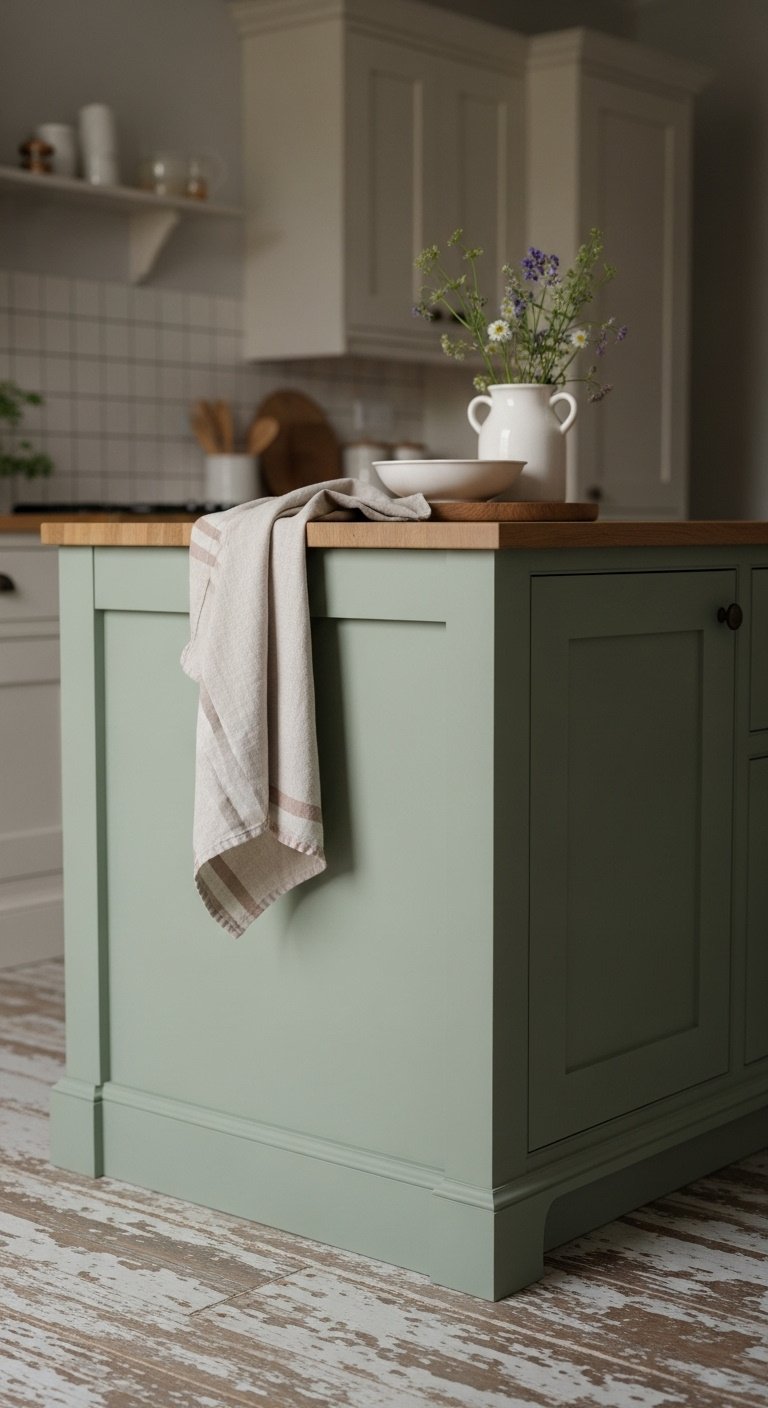
The foundation of any cottage kitchen is a color palette that feels light, airy, and serene. Forget harsh, bold colors and instead lean into soft, muted tones that evoke a sense of calm and nostalgia. Think creamy whites, warm greys, soft pinks, dusty light blues, and especially earthy greens like sage or mint. These colors create a relaxed and inviting atmosphere and serve as the perfect backdrop for natural wood tones and vintage accessories.
Actionable Steps:
- Materials Needed: Quality interior paint (eggshell or satin finish), paint rollers and brushes, painter’s tape, drop cloths, primer (if needed).
- Step-by-Step Directions:
- Choose Your Base: Select a primary neutral like creamy white or soft grey for walls or main cabinetry. This creates a bright canvas.
- Select an Accent: Pick one or two pastel or muted tones (e.g., sage green, dusty blue) for a kitchen island, a single accent wall, or the lower set of cabinets.
- Prep Your Surfaces: Thoroughly clean and sand any surfaces to be painted to ensure proper adhesion. Apply painter’s tape to protect edges and cover floors with drop cloths.
- Apply Paint: Apply 1-2 coats of primer, especially if you’re making a drastic color change. Follow with 2 coats of your chosen color, allowing for the recommended drying time between coats for a smooth, durable finish.
Pro-Tip: Always test your paint swatches on the wall and observe them at different times of day. Natural light can dramatically change how a soft, muted color appears in your space.
Pin this color inspiration for your dream cottage kitchen!
2. Display Your Treasures with Open Shelving
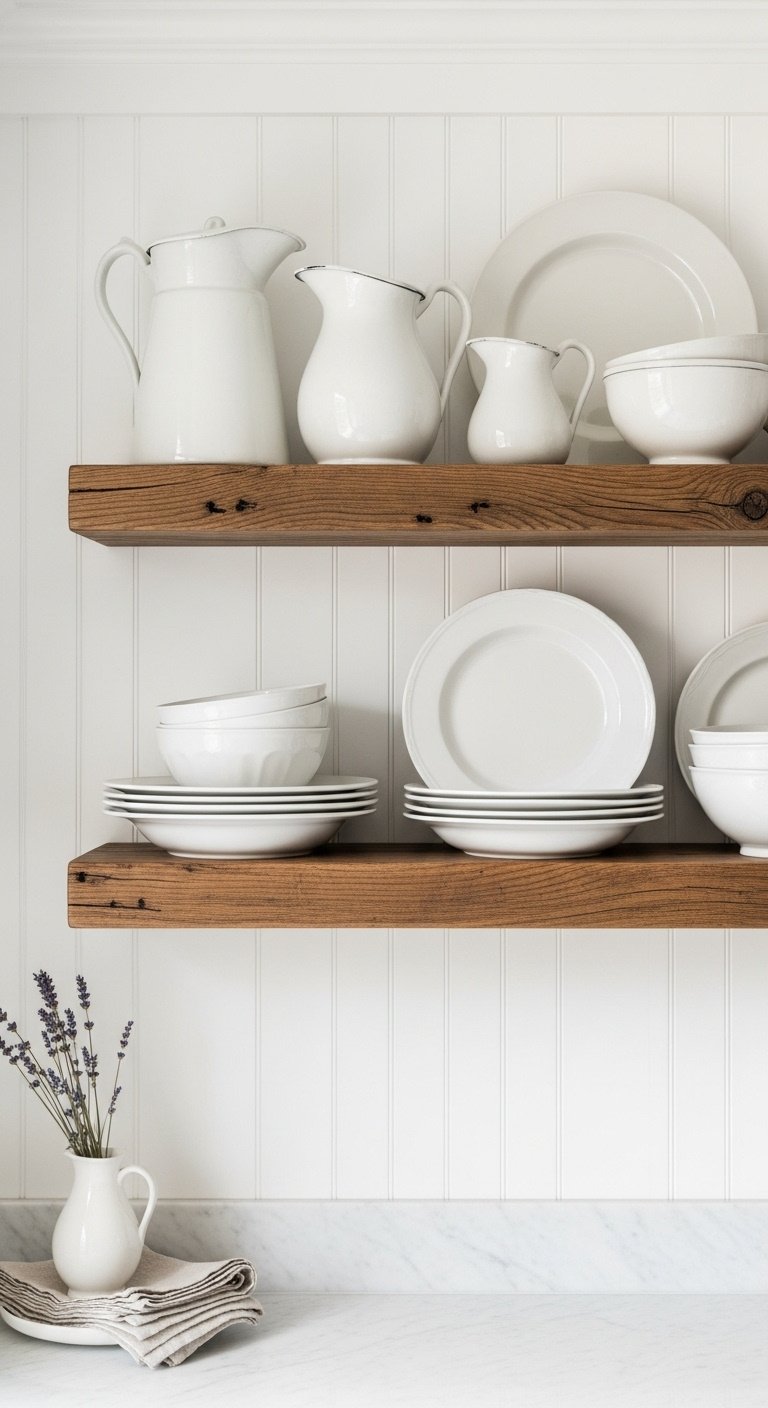
Open shelving is a hallmark of cottage style, offering a perfect blend of practical storage and decorative display. Replacing a few upper cabinets with simple, reclaimed wood shelves instantly opens up the space, making it feel lighter and more personal. It’s your chance to showcase favorite vintage dishware, beautiful glassware, ceramic pitchers, and copper mugs, turning everyday items into part of the decor.
Actionable Steps:
- Materials Needed: Reclaimed wood planks or thick shelving boards, decorative brackets (vintage iron or brass), a level, a drill, wall anchors, and a measuring tape.
- Step-by-Step Directions:
- Plan Your Layout: Use painter’s tape to mark where you want your shelves on the wall. Check them with a level and ensure they are spaced appropriately to fit your dishes and decor.
- Secure the Brackets: Use a stud finder to locate wall studs for maximum support, which is crucial for holding heavy dishware. Drill pilot holes and securely fasten the brackets to the wall. Use heavy-duty wall anchors if studs aren’t available in your desired location.
- Install the Shelves: Place your wood planks onto the brackets and secure them from underneath with small screws so they don’t shift.
- Style with Purpose: Arrange your favorite dishes, glassware, and decor. Create visual interest by mixing heights and textures, and try grouping items in odd numbers like threes for better balance.
Lesson Learned: Don’t overcrowd your open shelves. The goal is a curated display, not cluttered storage. Leave some ‘breathing room’ around your items to keep the look light and airy.
Save this shelf styling idea to your Pinterest board!
3. Anchor the Room with a Farmhouse Sink
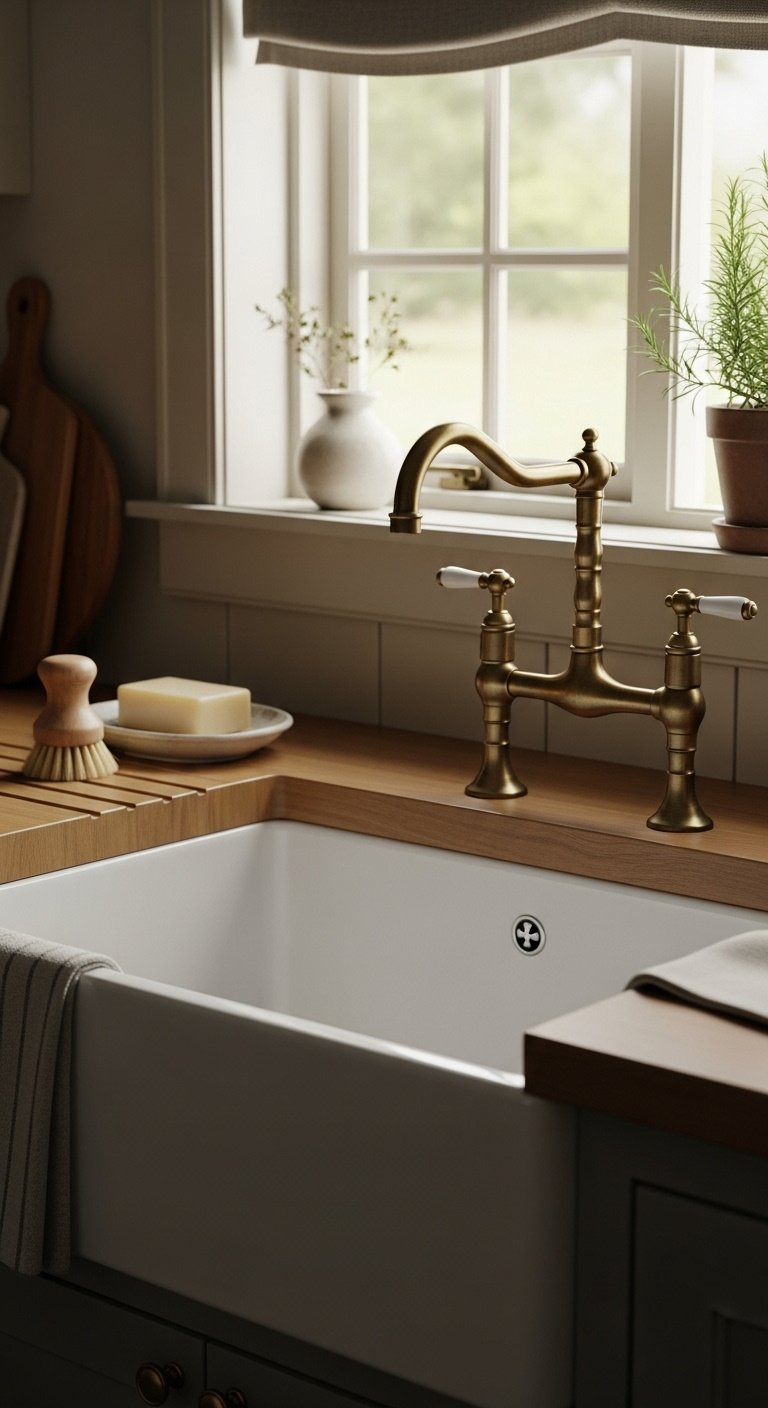
Nothing says “cottage kitchen” quite like a classic, deep-basin farmhouse sink. Also known as an apron-front sink, this fixture is both a practical workhorse and a stunning design centerpiece. Its exposed front adds immediate architectural character. Traditionally made from fireclay or cast iron, these sinks are incredibly durable and spacious enough to handle large pots and pans, making them as functional as they are beautiful.
Actionable Steps:
- Materials Needed: Farmhouse sink, bridge-style faucet, plumber’s putty, silicone sealant, measuring tape, jigsaw (for countertop cutout), and possibly support framing for the cabinet.
- Step-by-Step Directions:
- Measure and Support: Farmhouse sinks are extremely heavy. Your base cabinet must be properly supported and often needs to be custom-built or modified to the sink’s exact specifications.
- Template and Cut: Use the manufacturer’s provided template to trace the cutout shape onto your countertop. Carefully cut the opening using a jigsaw or appropriate tool for your counter material.
- Install the Sink: Lower the sink into the cabinet base and countertop opening. Apply a continuous bead of silicone sealant around the edges where the sink meets the countertop to create a waterproof seal.
- Install the Faucet: Mount the faucet and handles through the pre-drilled holes, using plumber’s putty under the faucet base to seal the connections. Connect the hot and cold water lines and the drain.
Pro-Tip: When choosing a faucet, a bridge-style or gooseneck faucet in a finish like unlacquered brass or polished nickel perfectly complements the vintage look of a farmhouse sink.
Love this classic look? Pin it for your kitchen renovation!
4. Warm Up with Reclaimed Wood & Natural Materials
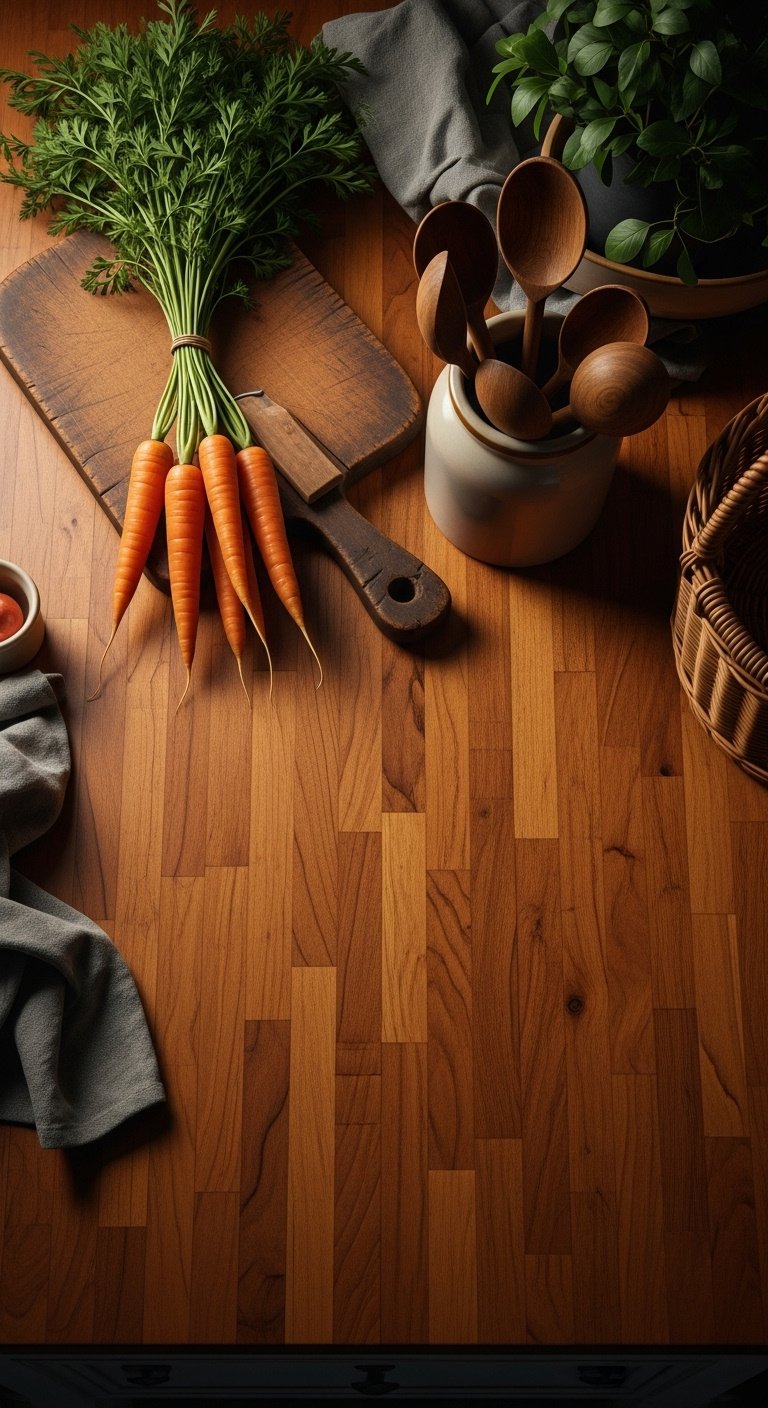
The key to avoiding a sterile kitchen is to introduce warmth and character through natural materials. Reclaimed wood is an essential element, adding a sense of history and tactility. Use it for open shelving, a kitchen island top, or even exposed ceiling beams. Butcher block countertops are another fantastic option that develops a beautiful patina over time. Complement these wood tones with other natural elements like wicker baskets for storage, stone accents, and ceramic pottery.
Actionable Steps (for conditioning butcher block):
- Materials Needed: A butcher block countertop slab, food-safe mineral oil or wood conditioner, fine-grit sandpaper, and clean cloths.
- Step-by-Step Directions:
- Clean the Surface: Start with a completely clean and dry countertop. For older surfaces, a light sanding with fine-grit sandpaper can smooth it out.
- Apply Oil: Pour a generous amount of food-safe mineral oil directly onto the wood surface.
- Spread Evenly: Using a clean, soft cloth, spread the oil evenly over the entire surface, including the edges and any corners. Don’t be shy; new or dry wood will soak it up quickly.
- Let it Soak: Allow the oil to penetrate the wood for at least 4-6 hours. For a brand-new countertop, letting it sit overnight is best.
- Buff Off Excess: Use another clean, dry cloth to wipe away and buff off any excess oil that hasn’t been absorbed. Repeat this process monthly to keep your butcher block hydrated and looking its best.
Pro-Tip: For a truly authentic look, search for reclaimed wood from local salvage yards. Each piece has a unique history, knots, and grain patterns that add irreplaceable character to your kitchen.
Add this warm & rustic idea to your kitchen decor board!
5. Go Retro with Vintage-Inspired Appliances
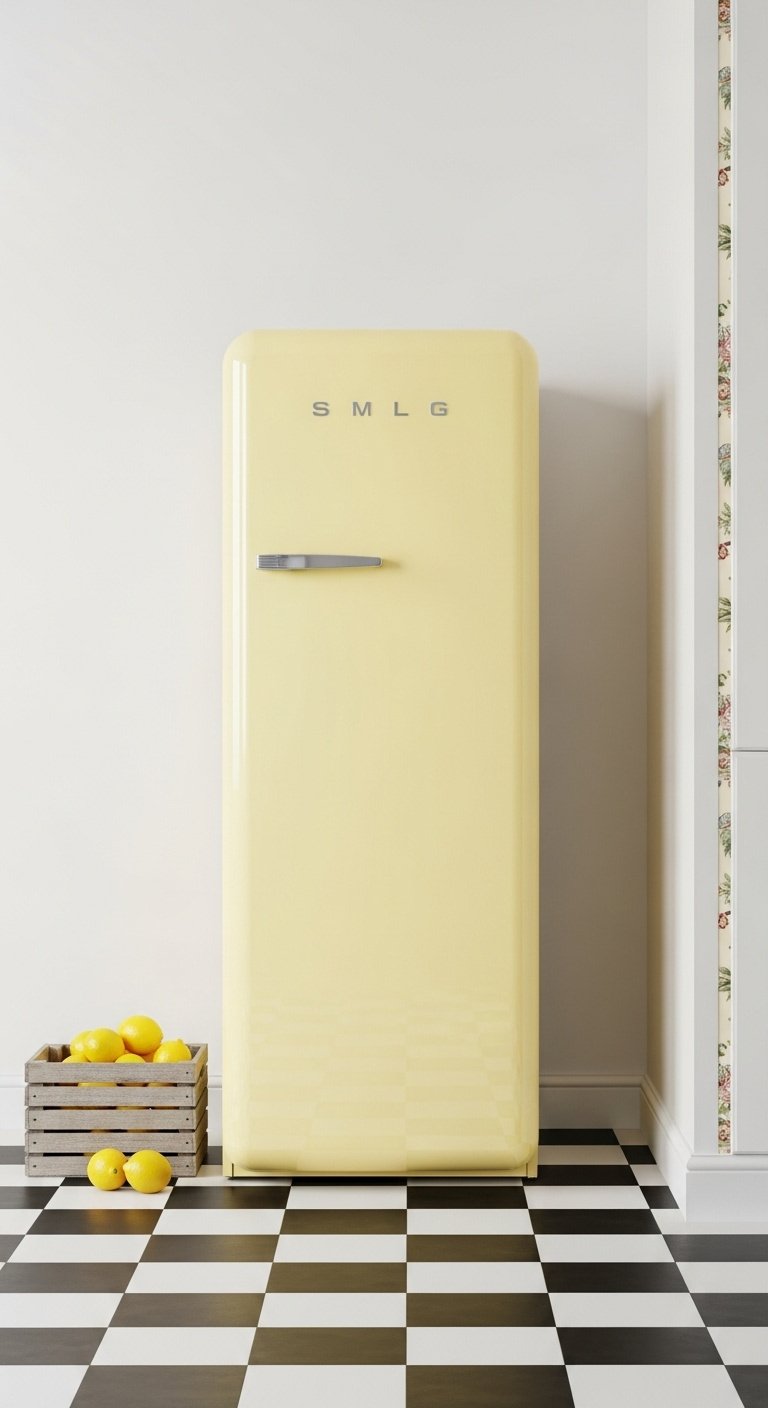
A statement appliance can serve as a playful and powerful focal point in a vintage kitchen. Modern appliance brands now offer retro-inspired lines that feature curved edges, classic hardware, and an array of pastel colors. A refrigerator in mint green or a classic-style stove in buttercup yellow can instantly inject personality and charm into your space, perfectly blending nostalgic design with modern technology.
Actionable Steps (for choosing the right appliance):
- Materials Needed: N/A (This is a purchasing and placement guide).
- Step-by-Step Directions:
- Decide on a Focal Point: Will it be a statement refrigerator or a classic-looking range? Choose one main piece to be the star, especially in a smaller kitchen, to avoid overwhelming the space.
- Select a Color: Opt for classic cottage colors like mint green, buttercup yellow, or robin’s egg blue for a playful pop of color. For a more subtle but equally stylish look, choose a retro design in cream or white.
- Measure Your Space: Vintage-style appliances can have different, sometimes bulkier, dimensions than standard modern ones. Triple-check your measurements for width, depth, and height to ensure a perfect fit.
- Balance Old and New: Pair your retro appliance with modern conveniences. Look for brands that offer vintage aesthetics with up-to-date technology and energy efficiency ratings.
Lesson Learned: While true vintage appliances are beautiful, they can be inefficient and difficult to repair. High-quality reproductions often provide the best of both worlds: timeless style and modern reliability.
Which retro color would you choose? Pin your favorite!
6. Add Character with Distressed & Painted Cabinetry
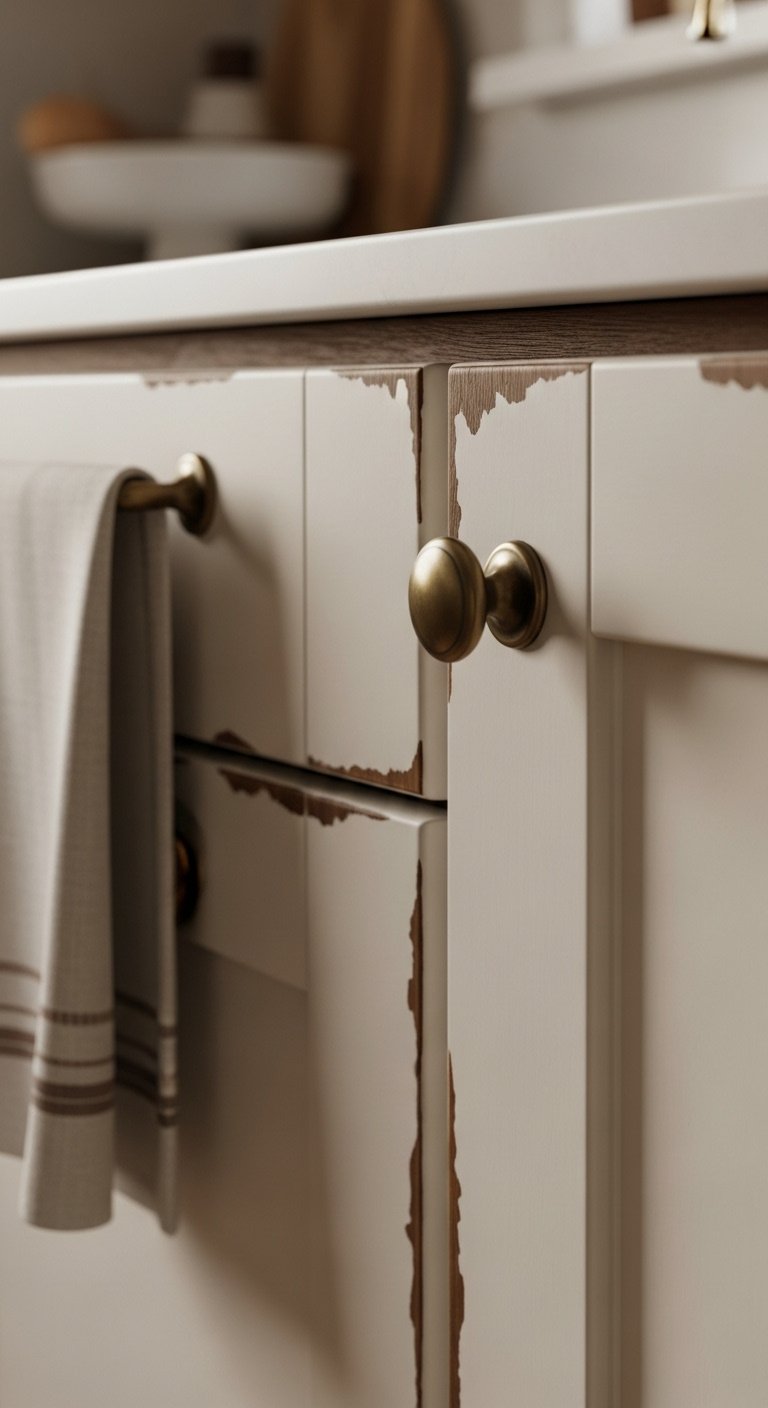
Cottage style cabinetry should feel timeworn and collected, not brand-new and flawless. If you have existing wood cabinets, a fresh coat of paint in a creamy white or soft pastel can work wonders. To take it a step further, consider a simple distressing technique to give them an aged appearance. This look pairs perfectly with simple Shaker-style cabinets and basic hardware in finishes like aged brass or polished nickel.
Actionable Steps (for a simple distressed look):
- Materials Needed: Medium and fine-grit sandpaper, chalk paint or milk paint, clear wax or polycrylic sealer, clean cloths, and a screwdriver.
- Step-by-Step Directions:
- Prep Cabinets: Remove all cabinet doors and hardware. Clean all surfaces thoroughly with a degreaser to remove any grease and grime.
- Lightly Sand: Lightly scuff the surfaces with medium-grit sandpaper. This helps the new paint adhere properly.
- Apply Paint: Apply two coats of your chosen paint (chalk or milk paint works best for achieving a matte, vintage look), letting it dry completely between coats.
- Distress Edges: Using fine-grit sandpaper, gently sand the edges and corners where wear would naturally occur over time. Focus on raised details and the areas around handles and knobs.
- Seal the Finish: Wipe away all sanding dust, then apply a coat of clear wax (for a soft, matte finish) or polycrylic (for more durability) to protect the paint and distressed finish.
Pro-Tip: For a layered, authentic look, apply a darker base coat (like a dark grey or brown) before your main color. When you sand the edges, the darker color will peek through, adding incredible depth to the distressed finish.
Pin this DIY cabinet idea for a budget-friendly update!
7. Tell a Story with Eclectic Decor & Vintage Accessories
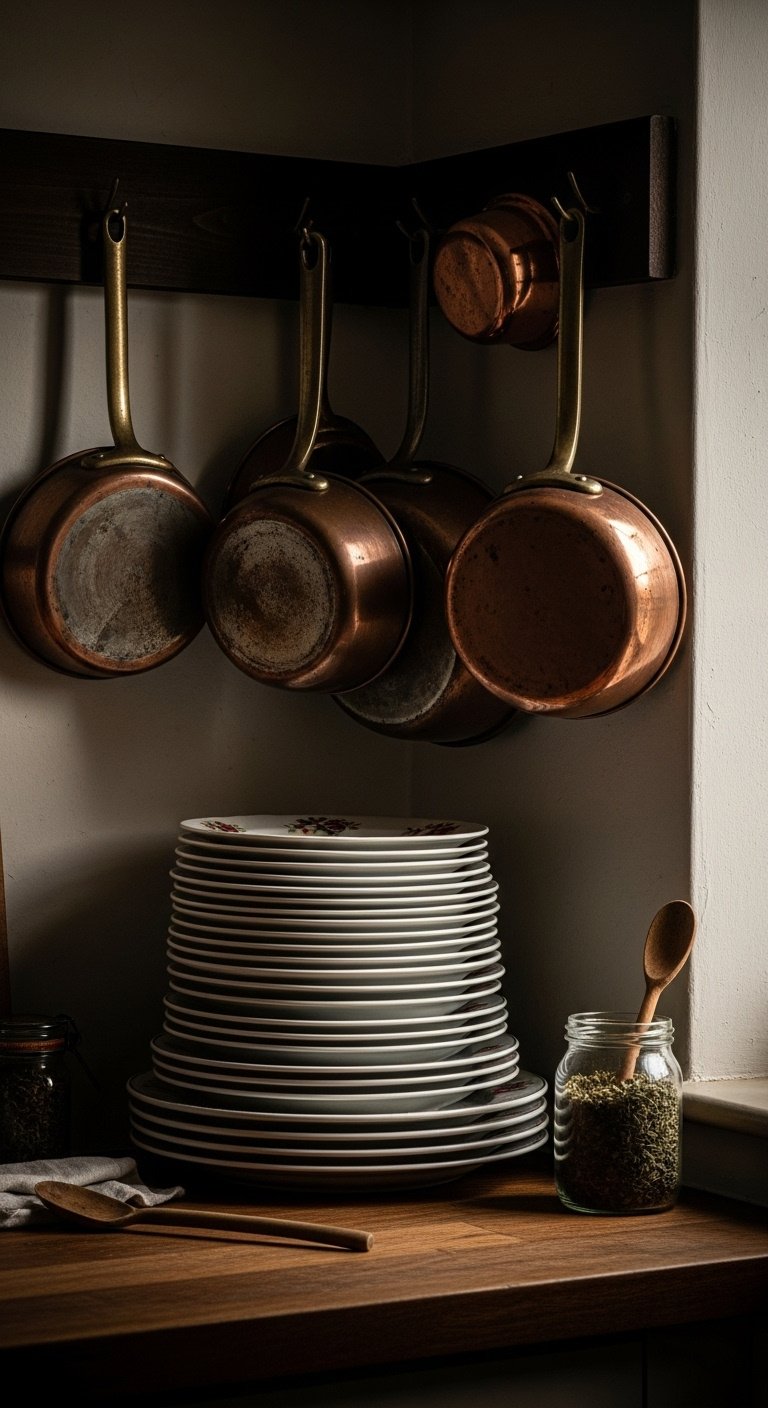
The true soul of a cottage kitchen comes from its collection of unique, personal, and eclectic decor. This is where you tell your story. Hunt for treasures at flea markets and antique shops. Display a collection of gleaming copper pots, arrange fresh flowers in a vintage pitcher, stack antique breadboards against the backsplash, and use charming wicker baskets for storing produce or linens. These small touches are what transform a kitchen into a home.
Actionable Steps (for creating a vintage vignette):
- Materials Needed: Wall hooks or a pot rack, vintage vases, wicker baskets, and your collection of vintage finds.
- Step-by-Step Directions:
- Choose a Surface: Select a small area to style, like a section of countertop, an open shelf, or a small side table.
- Create a Base: Start with a functional, textural piece that can anchor the display, like a large antique breadboard or a woven tray.
- Add Height: Place a taller item towards the back of the arrangement, such as a vintage ceramic pitcher filled with fresh flowers or a stoneware crock holding wooden spoons.
- Layer in Smaller Items: Add smaller, interesting objects in front, like a stack of small pinch bowls, a vintage kitchen scale, or a small piece of framed art leaned against the backsplash.
- Incorporate Life: Finish the vignette with something natural and alive, like a small potted herb or a bowl of fresh fruit, to add color and vitality.
Lesson Learned: The best cottage kitchens look like they’ve been collected over time. Don’t feel pressured to buy everything at once. Enjoy the process of hunting for unique pieces at flea markets and antique stores that truly speak to you.
What’s your favorite vintage find? Share this inspiration!
8. Ground the Space with Timeless Flooring
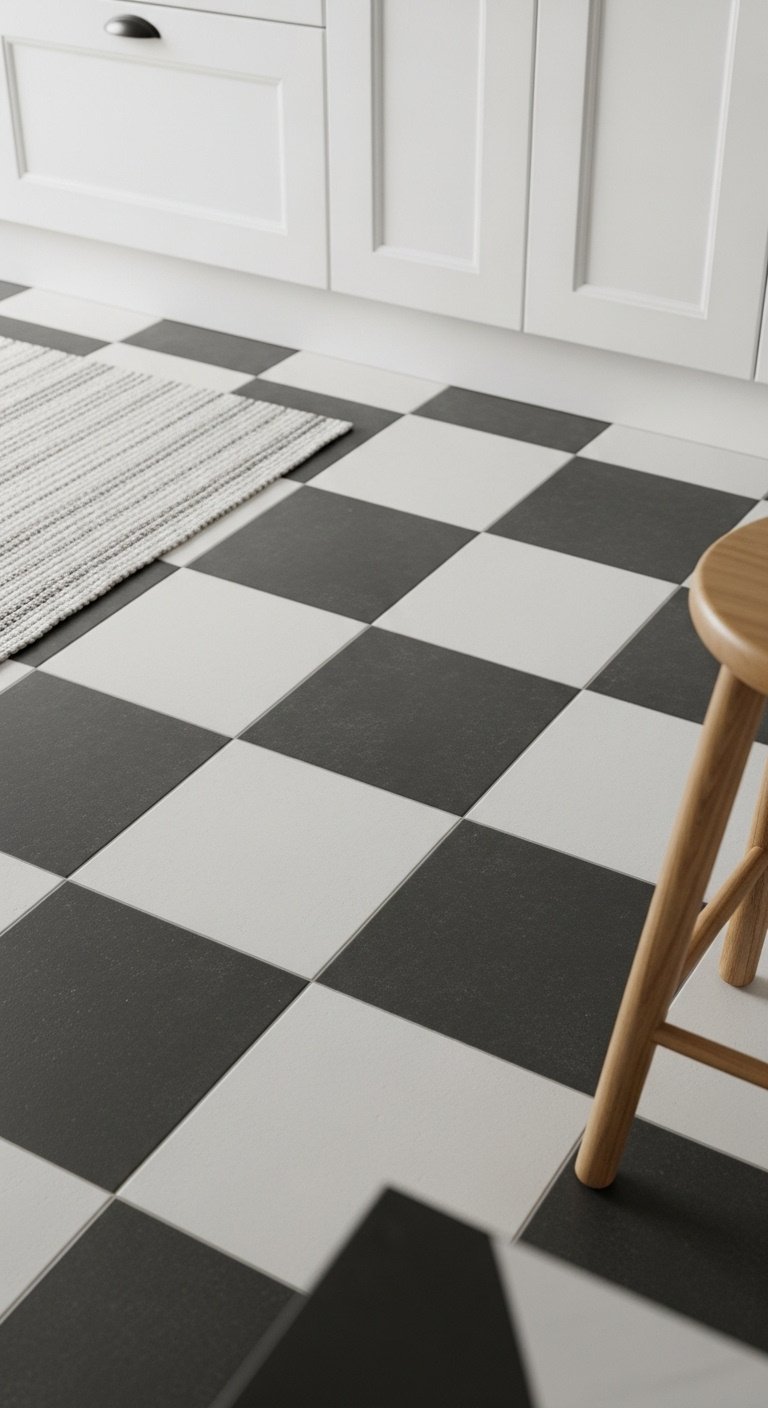
The right flooring can provide a classic foundation that anchors the entire design. Distressed wide-plank wood floors are a perfect choice, adding instant warmth and rustic charm. For a bolder, more retro-vintage look, a black-and-white checkerboard floor is a timeless classic that adds a touch of playful formality. Both options are durable and pair beautifully with the other elements of a cottage kitchen.
Actionable Steps (for a DIY Checkerboard Floor):
- Materials Needed: Peel-and-stick vinyl tiles (in black and white), a utility knife, a measuring tape, and a straight edge.
- Step-by-Step Directions:
- Prep the Floor: Your success depends on a good foundation. Ensure your existing floor is clean, dry, and perfectly smooth. Fill any cracks or holes.
- Find the Center: Find the center point of your room by snapping chalk lines from the midpoint of opposing walls. The intersection is your starting point.
- Start in the Middle: Begin laying your first tile precisely at the intersection of your center lines. This ensures the pattern is balanced across the room.
- Create the Pattern: Work your way out from the center, alternating black and white tiles. Press each one down firmly and ensure the edges are butted up tightly against each other.
- Cut Edge Pieces: When you reach the walls, measure the remaining gap and use a utility knife and straight edge to carefully cut tiles to fit perfectly into the space.
Pro-Tip: For wood floors, don’t shy away from imperfections. Knots, scratches, and slight color variations add to the authentic, timeworn character that is essential to the cottage aesthetic.
Click to save this classic checkerboard floor idea!
9. Set the Mood with Charming Lighting Fixtures
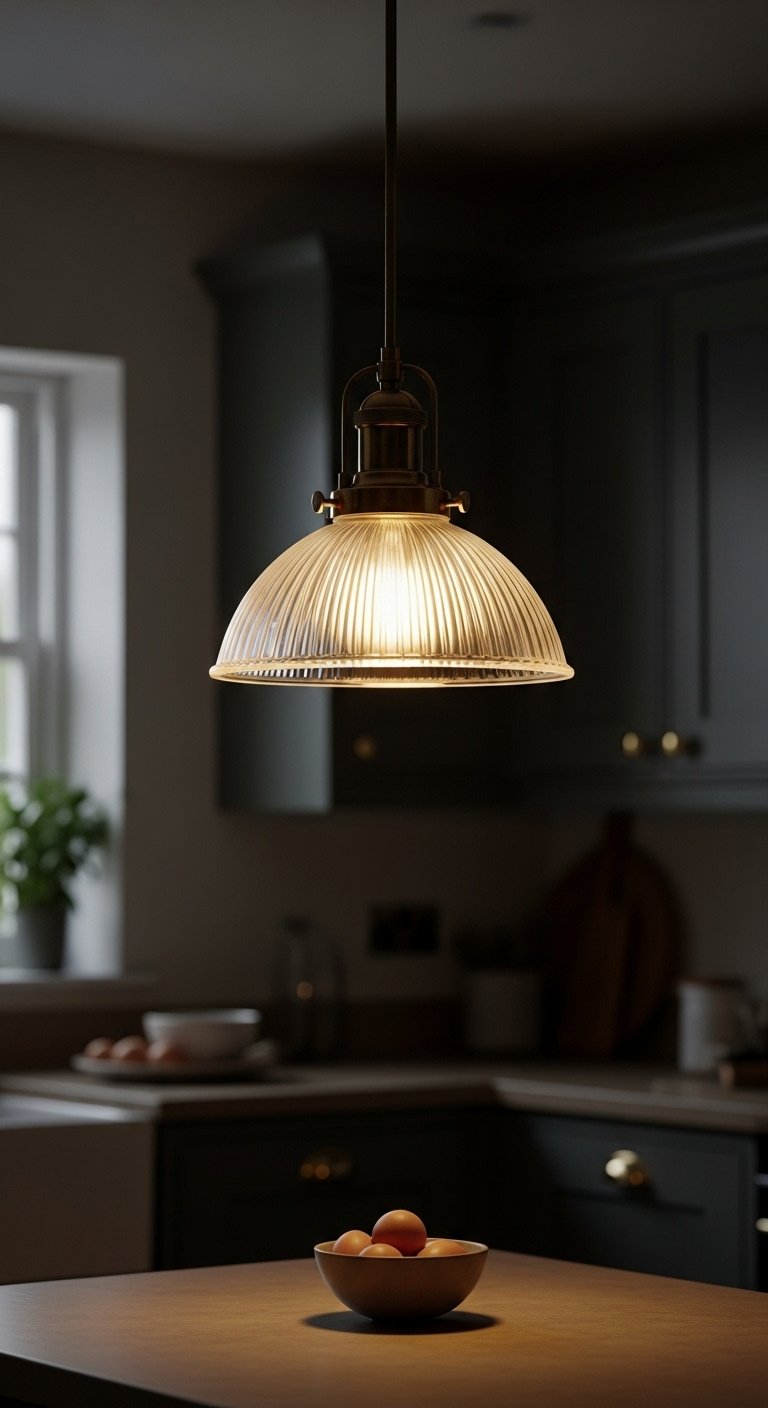
Lighting is crucial for creating a warm and cozy atmosphere. Choose lighting fixtures that act as characterful accents, rather than just functional necessities. Consider vintage-style or industrial pendant lights over the island, antique-inspired wall sconces for ambient light, or even a small, rustic chandelier over a dining nook. Look for materials like aged brass, iron, and fluted glass to enhance the vintage feel.
Actionable Steps (for replacing a fixture):
- Materials Needed: New light fixture, wire strippers, voltage tester, wire nuts, and a screwdriver.
- Step-by-Step Directions:
- Turn Off Power: SAFETY FIRST. Go to your home’s circuit breaker and turn off the power to the light fixture you are replacing.
- Remove Old Fixture: Carefully unscrew and lower the old fixture, then disconnect the wires. Use a voltage tester on the wires to confirm the power is completely off.
- Install Mounting Bracket: Attach the new fixture’s mounting bracket to the electrical box in the ceiling according to the product instructions.
- Connect Wires: Following the manufacturer’s instructions, connect the new fixture’s wires to the house wires using wire nuts (typically black to black, white to white, and the bare copper ground wire to the green screw or ground wire).
- Attach New Fixture: Secure the new fixture to the mounting bracket. Install light bulbs, turn the power back on at the breaker, and test your new light.
Lesson Learned: Layer your lighting. A central pendant over an island provides great task lighting, while wall sconces add a soft, ambient glow that makes the kitchen feel cozy and inviting in the evenings.
Light up your kitchen! Pin this vintage fixture idea.
10. Add Texture with Beadboard and Wall Paneling
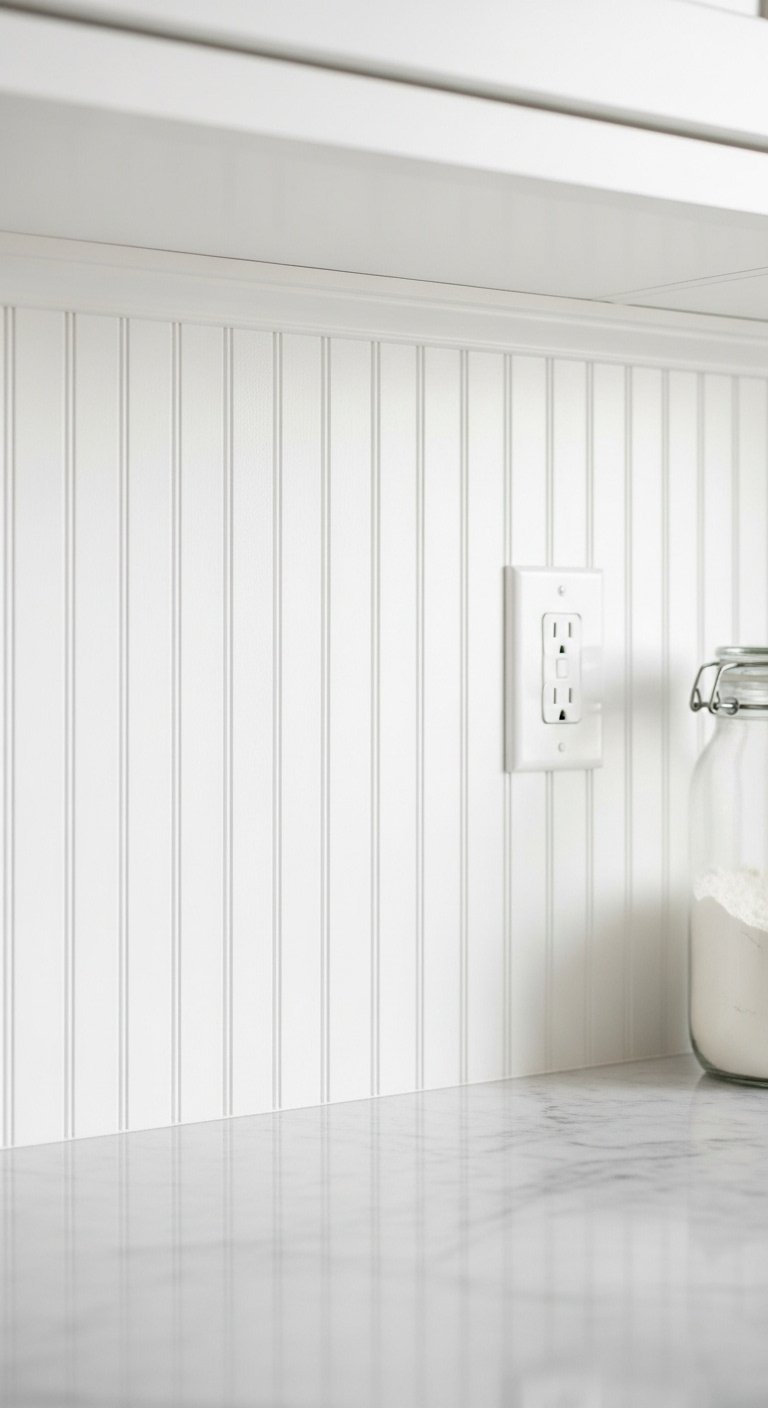
Plain drywall can feel flat in a cottage kitchen. Adding architectural texture with wall paneling is an easy win. Beadboard is the quintessential choice for cottage style. It’s perfect for a classic backsplash, wainscoting on the lower half of the walls, or even covering a kitchen island. It adds timeless, subtle texture and visual interest that instantly elevates the entire room.
Actionable Steps (for a beadboard backsplash):
- Materials Needed: Beadboard panels, construction adhesive, measuring tape, circular saw or jigsaw, nail gun, caulk, and paint.
- Step-by-Step Directions:
- Measure and Cut: Measure the height and width of your backsplash area. Carefully cut the beadboard panels to size, making precise cutouts for any electrical outlets or switches.
- Apply Adhesive: Apply a generous amount of construction adhesive to the back of the panel in a serpentine or “S” pattern.
- Install Panel: Press the panel firmly against the wall, ensuring it’s level. Use a nail gun to secure the panel at the top, bottom, and into wall studs for a secure fit.
- Finish the Seams: Apply a bead of paintable caulk to any seams between panels and along the edges where the beadboard meets the countertop and cabinets for a seamless, professional look.
- Paint: Once the caulk is dry, paint the beadboard in your desired color. A semi-gloss finish is often recommended for backsplashes as it’s easier to clean.
Pro-Tip: For a more authentic, high-end look, use individual tongue-and-groove planks instead of large panels. It’s more time-consuming to install, but the resulting deep shadow lines add incredible depth and character.
Add timeless texture to your kitchen! Save this beadboard idea.
11. Create a Cozy Hub with Comfortable Seating & Dining Nooks
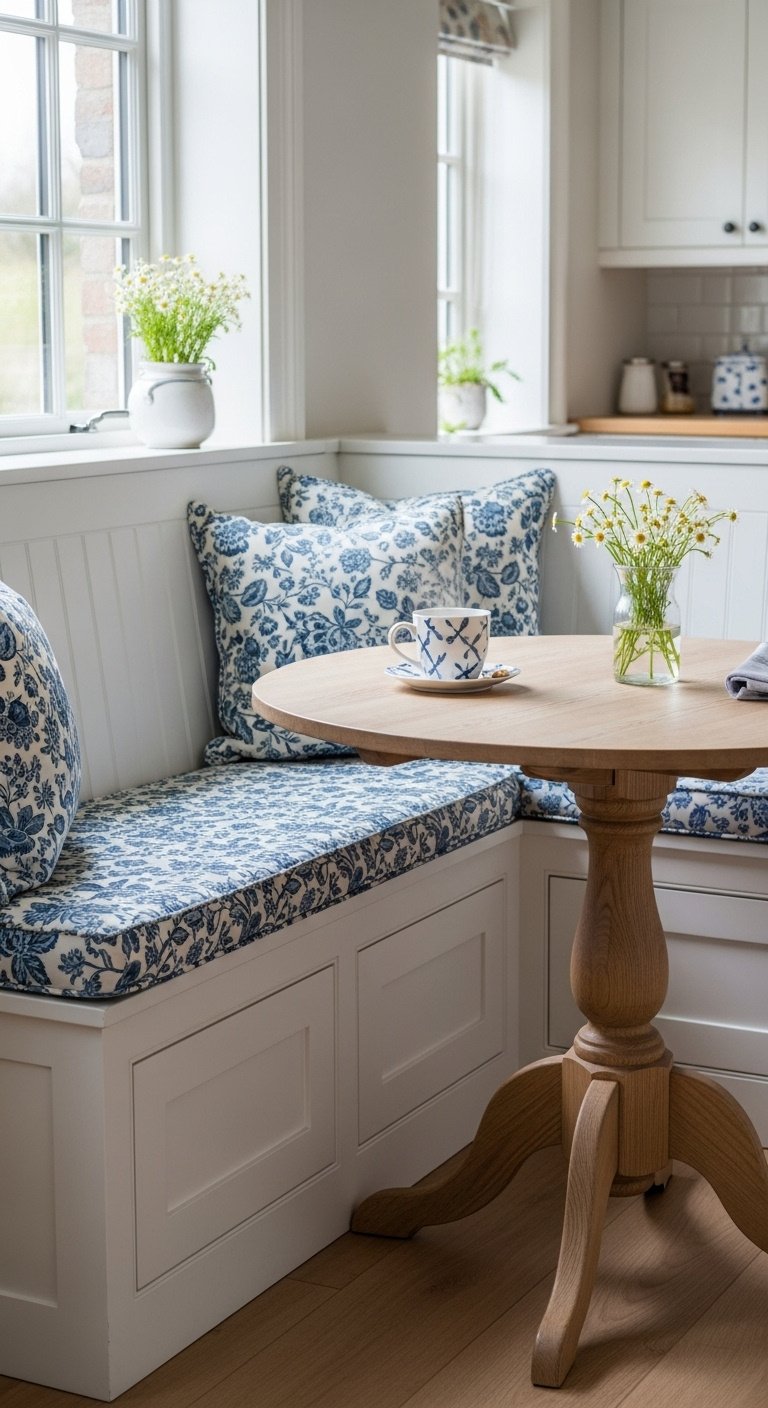
A cottage kitchen should be a gathering place. Carving out a cozy dining nook makes the kitchen a true hub. If you have the space, a built-in window seat piled high with floral or gingham pillows is the dream. Even in a small kitchen, you can create a charming spot with a small vintage farm table and a couple of mismatched wooden chairs. The goal is to create an inviting space that encourages family and friends to linger.
Actionable Steps (for a simple dining nook):
- Materials Needed: A small round or square table, two to four mismatched vintage chairs, decorative pillows, and a small area rug.
- Step-by-Step Directions:
- Define the Zone: Use a small, charming area rug (like a woven jute or vintage-style runner) to visually separate your dining nook from the main kitchen work area.
- Select a Table: Choose a small pedestal or simple farm-style table that fits the scale of your space without blocking traffic flow.
- Mix and Match Chairs: Hunt for vintage wooden chairs at thrift stores or flea markets. Don’t worry if they don’t match—this adds to the eclectic cottage charm. You can unify them by painting them all the same color if you prefer.
- Add Softness: Place comfortable, decorative pillows on the chairs or a nearby window seat. Soft textiles are key to making the space feel comfortable and encouraging people to sit and stay awhile.
Lesson Learned: A round table is often a great choice for small nooks as it has a smaller physical and visual footprint and encourages conversation by allowing everyone to face each other more easily.
Create your cozy corner! Pin this breakfast nook inspiration.
Key Takeaways: Your Quick Guide to a Vintage Cottage Kitchen
Feeling inspired? Here’s a quick summary of the most important elements to focus on as you start planning your dream vintage cottage kitchen:
- Color is Key: Stick to a palette of soft, muted colors like creamy whites, pastels, and sage green to create a light and airy feel.
- Embrace Natural Texture: Incorporate materials like reclaimed wood, butcher block, wicker, and stone to add warmth and authentic character.
- Focus on a Statement Piece: A farmhouse sink or a retro-style appliance can act as the perfect focal point for the entire design.
- Mix, Don’t Match: The charm is in the collected look. Combine new items with flea market finds, and don’t be afraid to mix different styles of chairs or dishware.
- Add Architectural Details: Elements like open shelving and beadboard paneling provide a timeless backdrop and add instant cottage character.
People Also Ask About a Vintage Cottage Kitchen
What is the best color for a cottage kitchen?
The best colors for a cottage kitchen are soft and muted to create a warm, inviting atmosphere. Creamy whites, soft greys, sage green, and pastels like dusty blue or buttercup yellow are popular choices. These colors pair beautifully with natural wood tones and vintage-style hardware to enhance the classic charm.
What is vintage cottage style?
Vintage cottage style is a design aesthetic that emphasizes comfort, charm, and a nostalgic, lived-in feel. It blends natural materials like wood and stone, comfortable furniture, and vintage or antique accessories. The overall look is personal, eclectic, and imperfect, favoring a collected-over-time appearance rather than a perfectly coordinated one.
How do I make my kitchen look like a cottage?
To make your kitchen look like a cottage, focus on key elements: paint cabinets in a soft white or pastel, install a farmhouse sink, use open shelving to display vintage dishware, and incorporate natural textures like butcher block countertops. Finish the look with vintage-inspired lighting, floral or gingham textiles, and eclectic accessories from flea markets.
What classic kitchen won’t go out of style?
A classic white kitchen with simple, clean lines, such as Shaker-style cabinets, will never go out of style. This timeless foundation is incredibly versatile. Paired with natural materials like wood or stone countertops and classic hardware, it creates a look that can be easily updated with accessories but whose core design remains eternally fresh and appealing.
Your Timeless Kitchen Awaits
Creating a vintage cottage kitchen is less about following a rigid set of rules and more about crafting a space that reflects your personality and feels like home. It’s a celebration of warmth, character, and the simple joys of a well-loved kitchen. By embracing imperfections, collecting items that tell a story, and focusing on natural textures, you can design a soulful space that is both beautiful and functional for years to come.
What’s the first project you’re planning for your own cottage kitchen transformation? Share your ideas in the comments below
